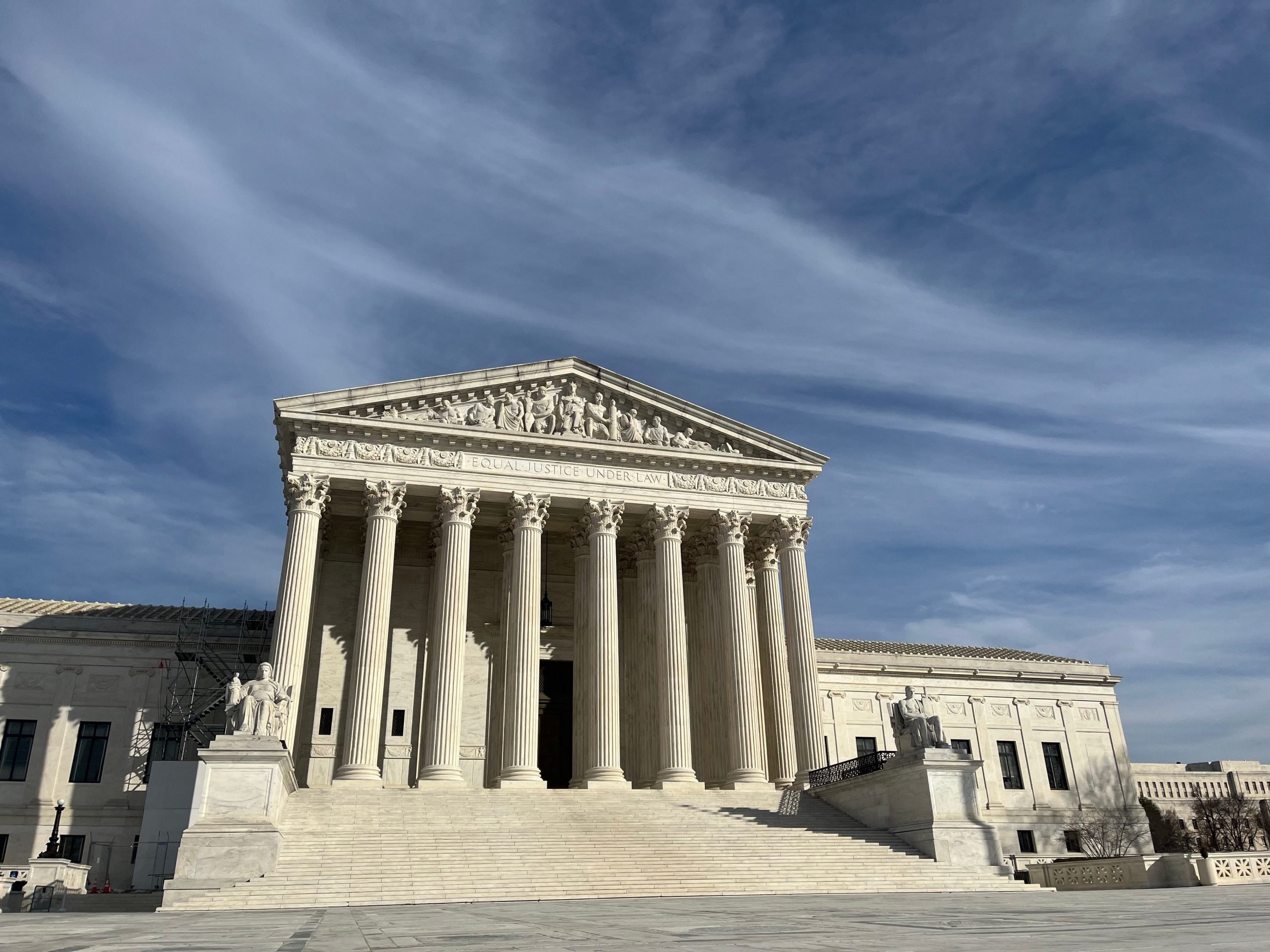Supreme Court upholds bar on guns under domestic-violence restraining orders


This article was updated on June 21 at 3:48 p.m.
The Supreme Court on Friday upheld a federal law that bars anyone subject to a domestic-violence restraining order from possessing a gun. By a vote of 8-1, the court ruled that the law does not violate the Constitution’s Second Amendment, which protects the “right of the people to keep and bear Arms.” The ruling in United States v. Rahimi was the court’s first Second Amendment case since it threw out New York’s handgun-licensing scheme nearly two years ago. In that case, New York State Rifle & Pistol Association v. Bruen, the majority emphasized that courts should uphold gun restrictions only when there is a tradition of such regulation in U.S. history.
The lower courts have struggled to apply the test outlined in Bruen, and the court on Friday provided more guidance for them to use going forward. Writing for the majority, Chief Justice John Roberts emphasized that the court’s Second Amendment cases “were not meant to suggest a law trapped in amber.” Instead, he explained, courts considering the constitutionality of restrictions on gun rights must determine “whether the new law is ‘relevantly similar’ to laws that our tradition is understood to permit, applying faithfully the balance struck by the founding generation to modern circumstances.”
The challenge to the law came from a Texas man, Zackey Rahimi. In 2020, a court in Texas entered a civil protective order against him after Rahimi dragged his then-girlfriend back to his car when she tried to leave after an argument. He pushed her into the car, causing her to hit her head on the dashboard. Rahimi also fired a gun at a bystander who witnessed the incident. The protective order specifically barred Rahimi from having a gun.
A few months later, when Rahimi was a suspect in a series of shootings, police obtained a warrant to search his home. They found a rifle and a pistol, which prompted prosecutors to charge him with violating the federal law at the center of the case.
Rahimi argued that the law violates the Second Amendment, and in the wake of the Supreme Court’s decision in Bruen, the U.S. Court of Appeals for the 5th Circuit agreed. It explained that although the government was not required to identify a “historical twin” to the law, it had not provided the kind of “well-established and representative analogue” needed for the law to survive.
On Friday, the court reversed the 5th Circuit’s decision. Roberts observed that “some courts have misunderstood the methodology of our recent Second Amendment cases,” and he cautioned against taking too rigid a view of the historical tradition required by Bruen. He noted that if courts looked, for example, only at what weapons were in existence in early U.S. history to determine whether the Second Amendment protects a particular firearm, it would only protect “muskets and sabers” – which is not the case. “By that same logic,” Roberts continued, “the Second Amendment permits more than just those regulations identical to ones that could be found in 1791.”
Instead, Roberts explained, courts should look at whether the modern regulation being challenged is “relevantly similar” to historical regulations. And in doing so, he stressed, courts should focus on the purpose of the regulation and the burden that it places on the Second Amendment right to bear arms. “For example,” he wrote, “if laws at the founding regulated firearm use to address particular problems, that will be a strong indicator that contemporary laws imposing similar restrictions for similar reasons fall within a permissible category of regulations.”
When that principle is applied to the federal law here, Roberts said, the law passes constitutional muster. Surveying early English and American gun laws, he concluded that since the founding of the United States, “firearm laws have included provisions preventing individuals who threaten physical harm to others from misusing firearms.” In particular, he pointed to two different kinds of laws in early English and U.S. history – laws that gave courts the power to require individuals who were believed to be a threat to post a bond, and laws that provided for the punishment of individuals who had threatened others with guns. When those two sets of laws are viewed together, Roberts wrote, they “confirm what common sense suggests: When an individual poses a clear threat of violence to another, the threatening individual may be disarmed.”
Even if the federal ban on the possession of guns by individuals subject to domestic-violence restraining orders is not identical to these two kinds of laws, Roberts continued, it is, for purposes of this test, sufficiently similar. Among other things, Roberts noted, the ban – like the other laws – was intended to reduce “demonstrated threats of physical violence,” and it only applies after a court has concluded that the individual “represents a credible threat to” someone else’s physical safety.
Roberts also devoted a paragraph to describing the errors that he saw in the 5th Circuit’s ruling. First, he said, the court of appeals interpreted Bruen “to require a ‘historical twin’ rather than a ‘historical analogue.'” But because Rahimi’s challenge to the law’s constitutionality was a facial one – that is, he argued that the law is always unconstitutional – the court of appeals should have focused on the scenarios in which the law “was most likely to be constitutional,” rather than (as it did) “on hypothetical scenarios” in which the law “might raise constitutional concerns.” “That error,” Roberts posited, “left the panel slaying a straw man.”
Although the ruling was a victory for the Biden administration, the majority rejected the federal government’s argument that Rahimi could be deprived of his right to have a gun because he is not a “responsible” citizen. “Responsible,” Roberts wrote, “is a vague term. It is unclear what such a rule would entail,” and there is no support for such a rule in the Supreme Court’s Second Amendment cases.
Justice Clarence Thomas, the author of the court’s decision in Bruen, was the lone dissenter. Unlike the majority, he believed that the federal government had not provided any evidence that the ban at issue here “is consistent with the Nation’s historical tradition of firearm regulation.” The early laws to which the majority points to support its holding, Thomas contended, are in reality too different from the ban here to serve as a historical analogue.
Rahimi’s case, Thomas concluded, “is not about whether States can disarm people who threaten others,” because states already have a way to do so – by charging the person making the threat with aggravated assault. The real question, he suggested, “is whether the Government can strip the Second Amendment right of anyone subject to a protective order — even if he has never been accused or convicted of a crime. It cannot,” he asserted.
Although seven justices joined Roberts in rejecting Rahimi’s challenge, several of them wrote separate concurring opinions to add their own views on the court’s latest elaboration on the “history and tradition” test.
Justice Sonia Sotomayor, joined by Justice Elena Kagan, who both dissented in Bruen, again voiced her belief “that Bruen was wrongly decided.” But Friday’s interpretation of the Bruen test, Sotomayor contended, was preferable to the one outlined by Thomas in his dissent. The former, she argued, “permits a historical inquiry calibrated to reveal something useful and transferable to the present day.” By contrast, she wrote, Thomas “would make the historical inquiry so exacting as to be useless, a too-sensitive alarm that sounds whenever a regulation did not exist in an essentially identical form at the founding.”
Thomas’s approach, she suggested, would be especially problematic in cases like this one, because it would not account for sociological changes over time. “Given the fact that the law at the founding was more likely to protect husbands who abused their spouses than offer some measure of accountability,” she said, it is no surprise that that generation did not have an equivalent” to the law at issue here.
Justice Ketanji Brown Jackson echoed Sotomayor’s disdain for Bruen, noting that she too would have joined the dissent if she had been on the court when the case was decided. She posited that the majority’s effort to clarify the Bruen test “is a tacit admission that lower courts are struggling” to apply that test. “In my view,” she wrote, “the blame may lie with us, not with them.”
Justice Amy Coney Barrett also pushed back against what she characterized as a requirement of “overly specific analogues,” describing “serious problems” that would flow from such a rule. It would, she argued, require “21st-century regulations to follow late 18th-century policy choices, giving us ‘a law trapped in amber.’ And it assumes that founding-era legislatures maximally exercised their power to regulate, thereby adopting a ‘use it or lose it’ view of legislative authority.” Instead, she wrote, Bruen requires a “wider lens” that looks for a principle. Although courts should not distill these principles at too high a level of generality, she noted, the majority has not done so here.
Justice Neil Gorsuch, on the other hand, appeared to agree with Thomas in taking a narrower view of what qualifies as a historical “analogue” for purposes of the Bruen test. But he agreed that the early English and U.S. laws on which the majority relied were precisely the kind of historical analogue that the federal government needed to provide.
Gorsuch acknowledged that Thomas “sees things differently.” “But if reasonable minds can disagree whether” the law at issue here “is analogous to past practices originally understood to fall outside the Second Amendment’s scope, we at least agree that is the only proper question a court may ask.”
The Supreme Court is currently considering other petitions for review asking it to weigh in on the scope of the Second Amendment, including a challenge to an Illinois law and three municipal ordinances that seek to regulate assault weapons and high-capacity magazines – ammunition-feeding devices that can carry more than 10 rounds of ammunition, and a challenge to the federal law banning possession of guns by people convicted of felonies – including non-violent crimes. The justices could act on those petitions before they leave for their summer recess.
This article was originally published at Howe on the Court.
Posted in Merits Cases
Cases: United States v. Rahimi